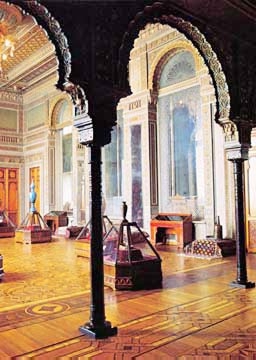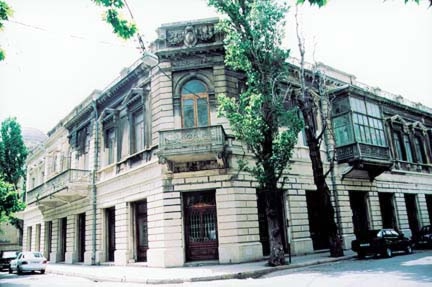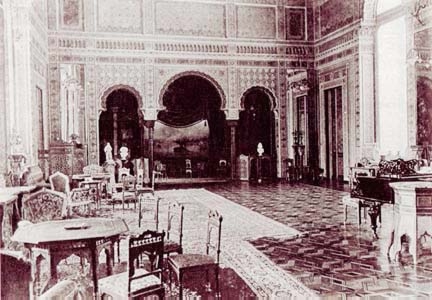|

Summer 2000 (8.2)
Pages
46-47
The Taghiyev
Museum
A Glimpse
of the Opulence of an Oil Baron
Other articles related to Zeynalabdin
Taghiyev, Baku Oil Philanthropist:
(1) Legacy
of the Oil Barons by Fuad Akhundov (AI 2:2, Summer 1994)
(2) Just for Kids: The
ABCs of Baku (Monogram of Taghiyev) in (AI 6.4, Winter 1998)
(3) Quote: Education
of Women - Haji Zeynalabdin Taghiyev (AI 6:3, Autumn 1998)
(4) Quote: Written
Word Brings Happiness - Haji Zeynalabdin Taghiyev (AI 8:1,
Spring 2000)
(5) Taghiyev's
Commitment to the Water Problem by Manaf Suleymanov (AI 10.2,
Summer 2002)
(6) Baku's
Search for Water: A Brief Chronology by Mammad Mammadov (AI
10.2, Summer 2002)
  Even
if you hate visiting museums, the Taghiyev National History Museum
is a "must-see" just to catch a glimpse of the opulence
and wealth of the Oil Baron period at the beginning of the 20th
century when Baku produced more than 50 percent of the world's
supply of oil. If you have time to visit only one site in Baku,
we highly recommend the Taghiyev Museum - 2nd floor. Even
if you hate visiting museums, the Taghiyev National History Museum
is a "must-see" just to catch a glimpse of the opulence
and wealth of the Oil Baron period at the beginning of the 20th
century when Baku produced more than 50 percent of the world's
supply of oil. If you have time to visit only one site in Baku,
we highly recommend the Taghiyev Museum - 2nd floor.
Left: Taghiyev's home was
converted into the National History Museum after the Bolsheviks
confiscated his property in 1920. Today, fortunately, the ornate
and lavish interior still exists to remind us of the opulence
of the Oil Baron period of 100 years ago.
When Oil Baron Haji Zeynalabdin Taghiyev (1823-1924) started
construction on a new residence for his family in 1895, he spared
no expense. Situated in the heart of Baku's center nearby the
Caspian Sea, the building was truly one of the most palatial
mansions in Azerbaijan, if not in the entire East. It has enormous
plate glass windows on the second floor, gilded arches, highly
ornamental ceilings, elaborate staircases and chandeliers.
The Italian Renaissance-style mansion is immense and takes up
an entire city block. It was designed by Polish architect Joseph
V. Goslavski, who later worked on Baku's City Hall and Taghiyev's
boarding school for Azeri girls and which today houses the Institute
of Manuscripts.
Inside the residence is an elaborate Oriental Salon and Taghiyev's
wife's sumptuous boudoir, complete with mirrored ceiling.
  When
the Red Army entered Baku in 1920, Taghiyev refused to leave
the country though most other wealthy entrepreneurs fled immediately
and established themselves in Europe. Others committed suicide
or were killed. When
the Red Army entered Baku in 1920, Taghiyev refused to leave
the country though most other wealthy entrepreneurs fled immediately
and established themselves in Europe. Others committed suicide
or were killed.
Taghiyev was in his late 90s at the time and decided to stay,
convinced that he had done so much for his country as a philanthropist
that no one would dare harm him or his family. To this day, Taghiyev
is esteemed as the most generous of the oil barons though he
was not the wealthiest.
Left: Taghiyev, though
not the wealthiest of oil barons at the turn of last century,
is esteemed today more than any of the others because of his
generous spirit of philanthropy throughout the city. Art by Orkhan
Huseinov.
In addition to his efforts in facilitating women's education,
he gave the city its first Dramatic Theater (now the renovated
Music Comedy Theater), a textile factory and the first covered
shopping arcade (Alizade Street).
Concerned about the lack of a reliable and pure water supply
In Baku, he organized for a ceramic pipeline to convey water
from Shollar springs in the foothills of the Caucasus near Dagestan
to Baku. This pipeline still operates as the most dependable
water supply for the city center today.
When the Bolsheviks took over the city in 1920, Taghiyev's residence
- like that of other wealthy oil baron's - was immediately confiscated
by the Bolsheviks. Taghiyev was able to move to his summer home
in Mardakan, a suburb of Baku, down by the sea on the Absheron
Peninsula.
Converted to a
Museum
Unlike the majority of mansions in the heart of the city, Taghiyev's
home was not divided into sub-units among numerous families who
were allocated one or two rooms and obliged to share kitchen
and bathroom facilities. Often today you'll see evidence of grand
dining rooms that were divided and walls built right up the middle
of the room to separate the living quarters of different families.

Photo:
Taghiyev's
residence has been converted into the National Museum of History.
The exterior is now being sandblasted - finally! Though not so
impressive from its exterior, inside, the second floor gallery
is breathtaking and well worth a visit.
Because Taghiyev's mansion was so elaborate, there seems to have
been a real desire to preserve it as a showpiece. Under a resolution
of the USSR People's Commissariat, the residence was established
as a museum in June 1920, only a few months after the Bolsheviks
took over Baku. Initially it was called "Muzexcurs"
(Museum Excursion). Later, the museum was divided into sections.
For a while, one part featured literature exhibits until the
Nizami Literature Museum was established.

Photo: Interior of Taghiyev's
residence - second floor as it was when Taghiyev lived there.
In 1939, the history exhibits were moved to the Shirvanshah Palace
in Ichari Shahar (Inner City) to make way for the Soviet Cabinet
of Ministers to set themselves up in the spacious oil baron's
home. In 1953 (after Stalin's death), the historical materials
were returned and the residence was once again designated as
the history museum.
Between the 1950s and 1960s, the History Institute of the Academy
and the history archives were also located there.
Today the building is still used as a museum; its main gallery
on the second floor with its elaborate gilt ceilings is also
used for official state receptions.
Naturally, one of the most striking aspects of the Taghiyev Museum
is the building itself. Some of the original furniture is still
there, including some wardrobes, tables, desks and chairs. Only
four fireplaces remain today. From the roof, it's easy to see
that there were many more fireplaces originally.
Unique Exhibits
While the building itself will take one's breath away, there
are several other items that deserve attention. In total, there
are about 350,000 items either on display or in storage. In the
Ethnographic Collection, for instance, there is a human jawbone
that was found in the Azikh cave in Western Azerbaijan. Scientists
estimate that it is 300,000 to 350,000 years ago.
History buffs will also be interested in the bejeweled sword
that was presented to Taghiyev by the Emir of Bukhara. It was
later confiscated and offered as a gift to Yefremov, the Bolshevik
who brought the 11th Red Army and took over Baku in 1920. There
is even an inscription on the sword indicating that it was presented
to Yefremov. Though the Museum authorities tried to get rid of
the inscription, they found it impossible. Of course, that's
part of history, too, despite how black its pages may be. Somehow
the sword remained in the museum and did not find its way out
of the country.
Though Taghiyev was illiterate himself, he had a valuable collection
of books in his library, most of which are still kept in the
museum. It includes a rare set of the Encyclopedia of Brokgaus
and other books on history and geography. Some of the art works
that he collected are on display in the National Art Museum.
Another special feature in the museum relates to music. You'll
find a collection of instruments that belonged to some of the
most famous musicians of Azerbaijan, including maestro Niyazi's
golden baton, Gurban Primov's tar, Asaf Zeynallov's cello and
Ahmad Bakikhanov's tar.
Taghiyev
National History Museum
4 Taghiyev Street
Hours: Monday to Friday, 10 a.m. to 5 p.m.
Admission: Tourists - $1; Adults - 1,000 manats; Children - 500
manats
Naila Valikhanli, Ph.D., Director of
the Taghiyev Museum contributed to this article.
From Azerbaijan
International
(8.2) Summer 2000.
© Azerbaijan International 2000. All rights reserved.
Back to Index
AI 8.2 (Summer 2000)
AI Home
| Magazine Choice | Topics
| Store
| Contact
us
|




